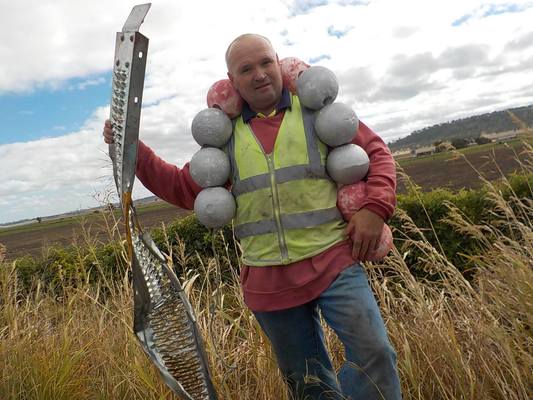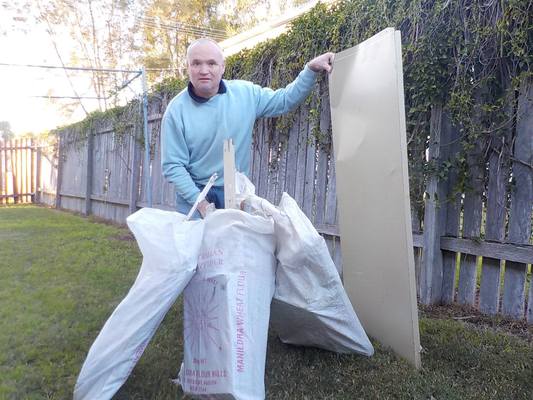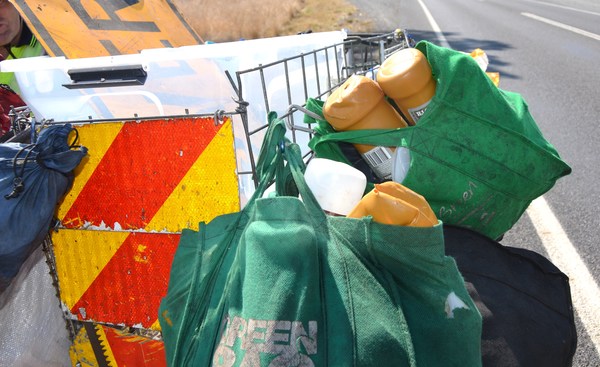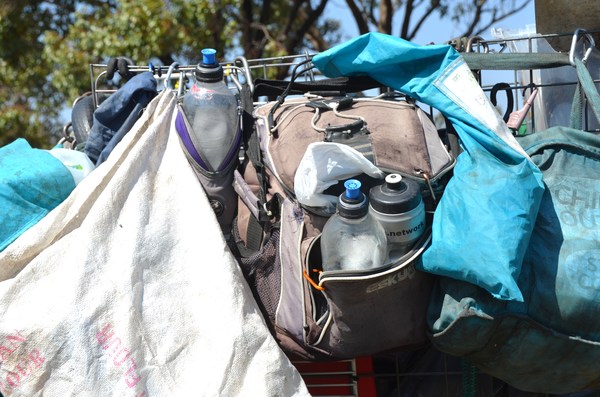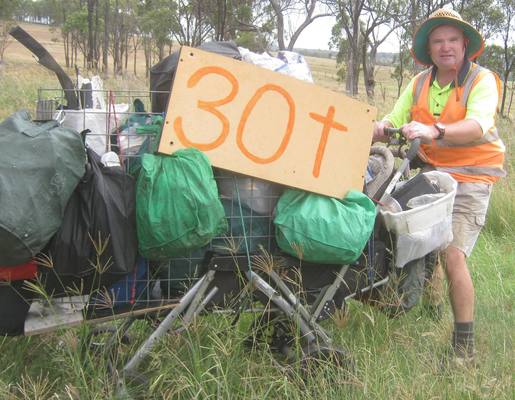
By Jeremy Sollars
The list of items Leonard Monaghan has collected on roadsides across the Warwick area in nearly a decade is almost endless – but he says the most important thing he’s picked up is “a sense of purpose”.
Known on Facebook as the ‘Warwick Rubbish Rambler’, Leonard is on a one-man quest to clean up roadside and other public litter from around our fair city and its surrounds.
He’s a familiar sight to truckies and other regular highway and road users as he pushes his ‘Wheel Thing’ – a self-constructed waste removal and transport facility – on an almost daily basis across the district.
The ‘Wheel Thing’ is actually a series of such self-propelled vehicles, which Leonard assembles both from donated and discovered stroller, bike and other parts.
But even more impressive are the statistics from his rubbish rambles, which involve an average of around 10 kilometres a day, most days of the week. Since 2008 Leonard says he’s collected more than 46 tonnes of rubbish – and he’s not talking out of his hat either, he weighs the results of his collecting daily.
And at the time of the Free Times going to print this week, his total for 2017 alone had just tipped over the 5000 kilo mark – on Monday alone the haul weighed in at 38.4 kilos, after enduring the cool change over the weekend and a bit of rain.
The Free Times caught up with Leonard last week while he was cleaning up the stretch of the Cunningham Highway west of Warwick, between Lyndhurst Lane and Sandy Creek Road.
It happened to be his biggest week of all – a staggering 250 kilos in total – capping of his biggest-ever month with 810 kilos of rubbish removed from our roadsides.
“I started walking back in 2008 for exercise,” Leonard explained.
“I became very surprised and annoyed at the amount of rubbish I came across while out walking and that’s what led to me doing what I do.
“I had the idea I could single-handedly clean up the whole area and really I’ve been expecting rubbish to decline.
“But if anything, the problem seems to be getting worse.
“I think people are generally becoming more careless with what they throw out of the car window.”
Leonard says tyres are “a big problem”, with people avoiding the fee charged for tyre disposal at council waste facilities.
“Tyres are particularly bad along the Killarney Road – Dead Horse Lane is a major spot as it’s near the dump,” he said.
“When I come across large amounts of tyres I report it to the council.
“Plastic and glass bottles are by far the most common item – if there’s been a grass fire on the side of the road you find a lot more.”
Leonard declined to comment in detail on some of the more bizarre items he’s stumbled across – let’s just say they’ve been of an ‘adult’ variety, begging the question as to how they found their way out of a car window in the first place.
Clothes are a common find – and they’re often in surprisingly good condition.
“I suppose they just blow off the back of utes or whatever it might be,” he said.
“All of my gloves I’ve found while out collecting – I’ve got about a dozen pairs at home at the moment.”
Leonard carries a plentiful supply of water on the ‘Wheel Thing’, and his choice of footwear is obviously critical, opting for comfortable sneakers rather than work or safety boots.
“I have a preferred brand that I get from Big W – a lot of shoes give me blisters but these are just particularly comfortable and don’t give me any problems,” he said.
“I go through about six pairs a year.”
As well as tyres, Leonard also reports other discoveries while out on the road – such as potholes and other safety hazards – to the relevant authorities, such as the council or Transport and Main Roads.
He says he’s had no near misses while working on the side of the highway, and often gets a friendly toot on the air horn from truckies who have come to recognise him, “and people sometimes pull up and give me rubbish”.
Dead animals are something of an occupational hazard, but can also be of interest – like the body of an endangered quoll he came across in the Bracker Road area a few years back.
Where does all the rubbish go?
Leonard has a sizeable sorting facility at his Warwick home and separates recyclables and non-recyclables out on the road, transferring them to a large number of bins in the backyard.
“I generally fill up the station wagon about once a fortnight and take a load to the dump,” he said.
“Some of the recyclables end up in the dump shop – I’m happy for that to happen.
“I’ve been dropping off cans I pick up to Warwick East State School for the last few years.”
When asked what’s the best thing he’s discovered in his years of roadside rambling, Leonard is quickly to the point.
“A sense of purpose,” he says, with a quiet smile.
If you know of any particular rubbish ‘hot spots’ around the traps, give Leonard Monaghan a call on 4667 0041 or on 0488 405 160, or email rubramble@ausi.com
And follow his rubbish rambles on Facebook at ‘Warwick Rubbish Rambler” …
(BREAKOUT)
Fast facts on rubbish on the Southern Downs and Granite Belt …
* The population within the Southern Downs council region in 2016 was approximately 36,500.
* The amount of waste generated in the region from the main waste streams was about 41,000 tonnes last year – this represents almost 1.2 tonnes of waste per person per year (this does not include the amount of recyclables that is generated).
* Generation rate for the kerbside domestic waste stream – domestic recycling averages 2.54 kg per household per week, and domestic garbage averages 14.04 kg per household per week.
Warwick landfill (Warwick Central Waste Facility, Morgan Park) – the amount of waste to landfill at this facility has been estimated at between 15,000 and 19,000 cubic metres per year.
(BREAKOUT)
The Southern Downs Regional Council’s ‘Waste Goals’ …
* Goal 1 – The total amount of waste generated in the region is reduced by 10 per cent by 2025 to no more than 1.0 tonne per person per annum
* Goal 2: The amount of waste that is reused, recycled and recovered represents more than 40 per cent of the waste stream by 2025
* Goal 3: The disposal of waste is environmentally and socially sustainable.
* Goal 4: The community is educated about the real costs of waste and given the tools to manage and limit their own waste.
* Goal 5: Waste management is financially sustainable

